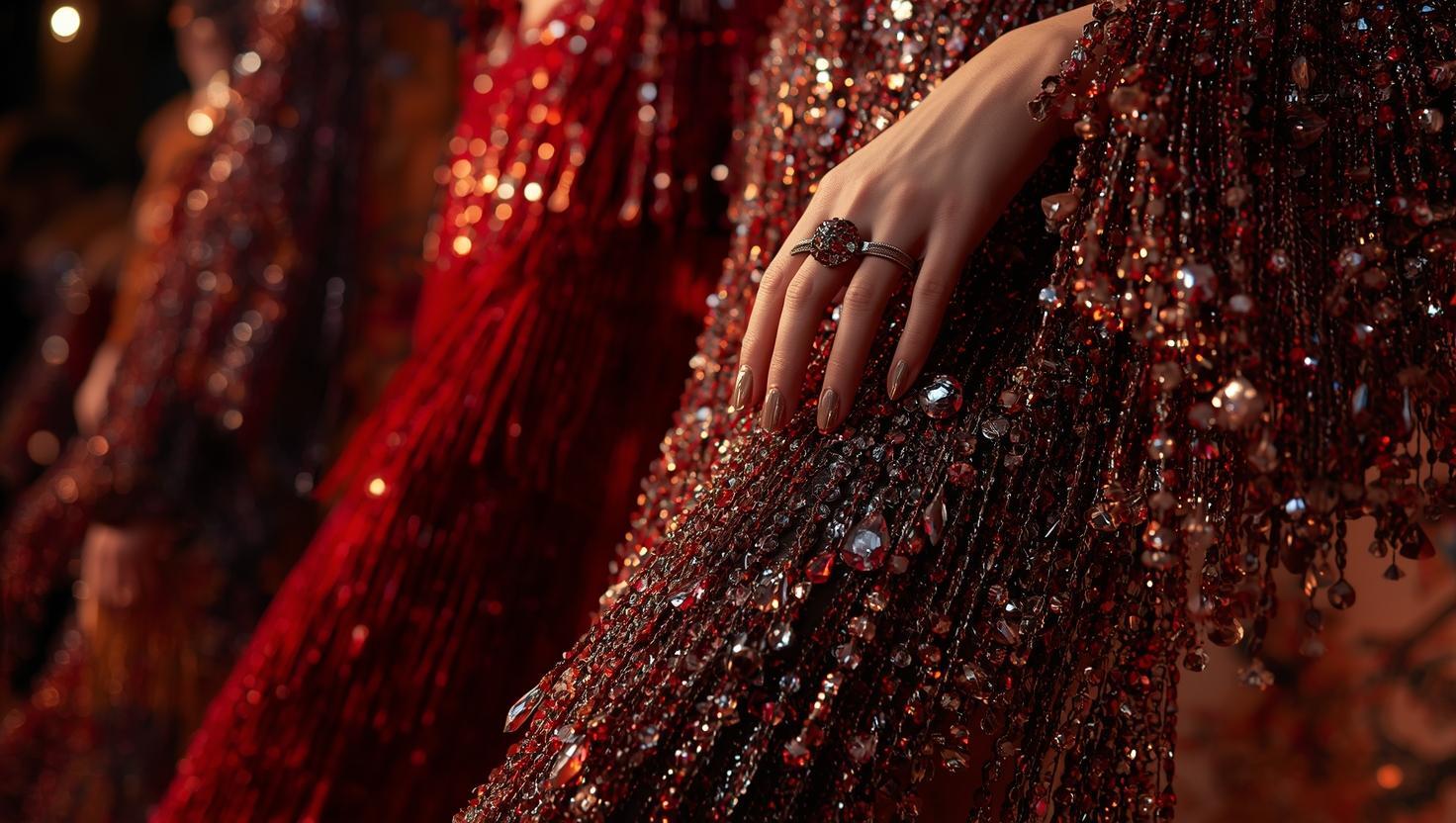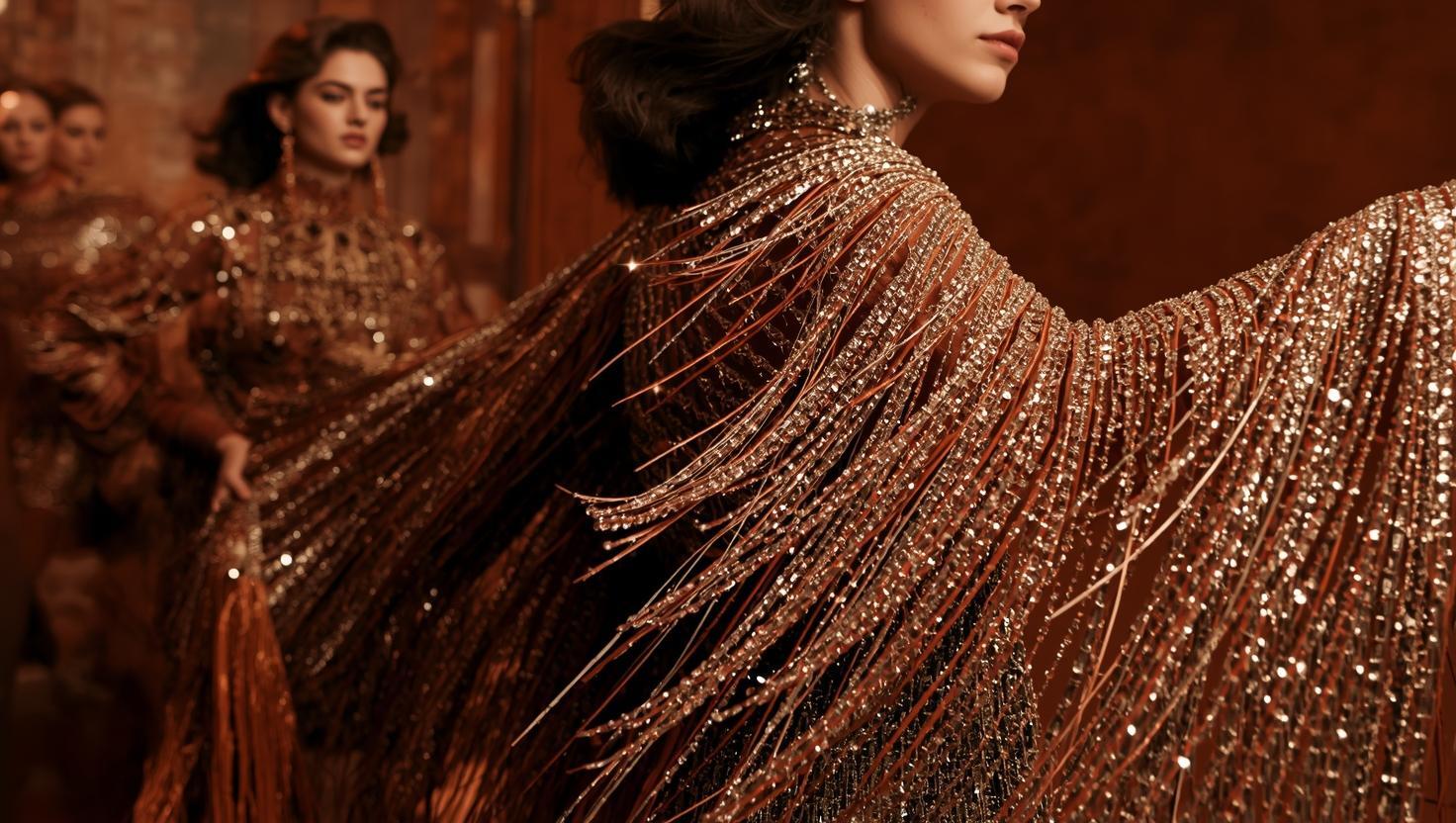18th Aug 2025
Crystal Fringe Revival: Sparkling Movement & Glamour in Fall/Winter 2025 Fashion

Fringe returns as an opulent focal point in Fall/Winter 2025, and you’ll see crystal strands and tassels bringing sparkling movement to coats and eveningwear; the revival injects opulence into your outfits while carrying a risk of overwhelming minimalist wardrobes, so you should balance shine with tailored basics for impact.
Reimagining Glamour: The Crystal Fringe Aesthetic
Crystal fringe amplifies the season's turn toward maximalism, giving your silhouettes kinetic sparkle that reads both nostalgic and modern; designers layer strands to catch runway lights and city streetlamps alike, turning a coat hem or sleeve into a deliberate statement piece that moves with your body and broadcasts opulence at every step.
Historical Context and Evolution
From the 1920s flapper tiers to 1970s disco exuberance and the red‑carpet beading of the 2000s, fringe has repeatedly resurfaced as a symbol of movement and showmanship; today you see that lineage reinterpreted through softer palettes and architectural dressing—Chanel's Grand Palais revival and Saint Laurent's gemstone detailing are direct nods to that arc.
Key Designers Leading the Charge
Prada and Valentino have used fringe to foreground individuality, while Saint Laurent, Chanel, Khaite, and Bottega Veneta translate it into luxury tailoring and romantic drape; Tory Burch and ACNE Studios signal the trend downstream via accessories that echo the same sparkling motion you can adopt into your wardrobe.
Look for Prada's inventive styling that pairs micro‑fringe with archival silhouettes, Valentino's Alessandro Michele‑led emphasis on tactile ornamentation, and Saint Laurent's mix of brocade and beading; many runway pieces feature hand‑applied crystals—often 200–800 per hem—so anticipate reinforced seams and dry‑clean only care when you bring that high‑movement glamour into your rotation.
Sparkle and Movement: The Art of Crystal Fringe in Motion
You watch crystal fringe turn static silhouettes into living light: strands catch every flash, creating a rhythmic shimmer that shifts with your pace. Designers from Prada to Valentino and Chanel used fringe to punctuate hems, sleeves, and capes this season, with lengths ranging from short micro-fringes to dramatic 20–30 cm tassels that produce sweeping light trails on runway walks, editorials, and social clips—making fringe not just a detail but a kinetic focal point in your look.
Signature Techniques and Fabrics
Hand-beading with Swarovski and Czech crystals, chain-link strands, and laser-cut acrylic rods are mixed with sequined tassels and metal spacers; bases include silk chiffon, tulle, organza, crepe-backed satin, and stretch mesh. You’ll notice strand spacing of 6–12 mm on high-density panels and fringe lengths commonly between 5–30 cm; heavier treatments often require reinforced hems and grosgrain tape to prevent sagging or seam failure.
The Role of Movement in Creating Visual Impact
Movement amplifies fringe: short 2–4 cm strands deliver micro-sparkle under camera strobes, while 15–30 cm lengths create visible trails that read on video and in person; designers staged sways, spins, and slow walks to showcase this, so you should pick fringe length based on how you move and where you’ll wear it—daylight, club lighting, and runway photography each react differently to the same piece.
Deliberate tailoring controls that impact—distribute 200–600 g of crystal weight across panels with reinforced stitch points, limit strand length at stress seams, and space attachments to avoid snagging or fabric distortion. On the runway, houses paired fringe with fluid chiffons or stretch linings to preserve drape; in street styling, you’ll want shorter fringe on outerwear and longer on skirts or sleeves for dramatic motion without compromising comfort or garment integrity.

Personal Style Reinvented: How to Incorporate Crystal Fringe
Styling Tips for Everyday Wear
Choose a single crystal fringe piece—bag, hem, or cuff—and let the rest of your outfit act as a calm canvas: tailored blazer, straight-leg jeans, or a fine-gauge knit work best. Limit sparkle to one focal point and aim for 1–2 contrasting textures to avoid visual clutter; designers at recent shows favored this restraint. For daytime, pair with matte wool or denim; for evening, swap the knit for satin or leather. Thou should balance the sparkle with matte textures—cashmere, suiting, or matte leather—to keep looks modern.
- crystal fringe: one statement piece per outfit
- soft power: pair fringe with slouchy tailoring
- mix prints: offset fringe with subtle stripes or checks
- peep-toe heels: echo 2025 runway shoes for evening looks
Statement Pieces and Layering Strategies
Treat a crystal-fringe coat, skirt, or cape as your outfit’s centerpiece and build up to two complementary layers—slip a silk blouse beneath a fringed camisole or wear a sleeved knit under a fringed mini for warmth and movement. Keep the silhouette streamlined: capes and cropped jackets work with high-waist trousers or pencil skirts to preserve proportion and motion.
Adopt tactical layering: start with a matte base (wool turtleneck, ponte trousers), add a mid layer that provides structure (single-breasted blazer or longline vest), then place your crystal fringe element on top so movement reads clearly on camera and in person. Try detachable trims to convert a blazer to eveningwear—swap buttons for a short fringe panel to transition from 9–5 to cocktail events in under 10 minutes. For footwear, pair with the season’s modern peep-toe heels or sleek ankle boots depending on occasion; for proportions, limit bulky knits when wearing long fringe to avoid adding more than 2–3cm of apparent width at hips or sleeves. Avoid layering multiple high-shine elements at once to prevent a costume effect and use one reflective surface to act as your focal point for a polished, runway-inspired outcome.

The Influence of Celebrity and Digital Culture on Crystal Fringe Trends
Red Carpet Moments and Their Impact
You watch crystal fringe explode into mainstream consciousness after a handful of high-profile appearances—designers like Valentino and Chanel inspire stylists who then dress stars for premieres and awards. A single red-carpet look can trigger immediate sell-outs of embellished pieces and propel fringe from runway novelty to wardrobe staple, while repeated celebrity repetition risks trend fatigue that flattens creativity and shortens a movement’s lifespan.
Social Media and the Rise of Individual Expression
You see platforms amplifying both the best and worst of the crystal-fringe revival: creators remix archival Valentino styling and Prada’s runway diversity into 15‑second edits, fueling a return to individuality, yet platform algorithms also compress expression into repeatable micro-trends that can make looks feel interchangeable.
You can expect influencers and micro‑stylists to democratize fringe by pairing crystal trims with denim, oversized blazers, or vintage finds—hashtags and short-form video turn runway cues into street styling how‑tos, encouraging DIY tailoring and upcycling while spotlighting small designers who translate opulent fringe into accessible price points; this decentralization both spreads the trend and challenges you to keep your take genuinely personal.
The Future of Crystal Fringe: Predictions for 2025 and Beyond
Expect crystal fringe to migrate beyond eveningwear into everyday pieces—bags, collars, and outerwear trims—after its showing across the four major fashion weeks in spring/summer 2025. You’ll spot designers from Prada to Saint Laurent and independent labels adopting sparkle as a tactile signature. Retail buyers will test limited capsules and made-to-order runs to manage inventory, while over-embellishment raises real sustainability risks if production isn’t carefully scaled.
How Trends Are Shifting in Response to Consumer Demand
You’ve already seen the shift toward individuality and soft maximalism on runways; consumers now want pieces that feel personal and collectible. Brands responded by offering customizable fringe lengths, mix-and-match trims, and styling guides—Prada and Valentino’s personalized runway looks serve as models. Expect resale-friendly designs and small-batch drops as brands balance demand for statement sparkle with the market’s appetite for uniqueness and longevity.
Potential Collaborations and Innovations
Design houses will partner with specialists—Swarovski for precision crystals, tech startups for motion-reactive modules, and ateliers skilled in hand-beading—to create hybrid products. You’ll see collaborations that fuse craftsmanship (Iris van Herpen–style 3D techniques) with commercial-ready finishes, producing fringe that moves, lights, or detaches for multiple styling options; these partnerships are the clearest path to scalable, wearable innovation.
Concrete examples already in motion include 3D-printed fringe components that reduce waste and permit complex forms without hand-cutting, and detachable crystal trims that transform a coat into eveningwear. You can expect couture ateliers to supply hand-sewn elements while brands like Loewe or Khaite pilot modular systems for retail. Collaboration with wearable-tech firms could produce motion-sensing fringe that amplifies movement on camera—a direct response to social-driven demand for garments that perform both IRL and online.
Conclusion
Upon reflecting on the Crystal Fringe Revival: Sparkling Movement & Glamour in Fall/Winter 2025 Fashion, you can see how shimmering fringe reintroduces kinetic luxury that elevates tailoring and eveningwear alike; you should balance these statement pieces with restrained silhouettes to let movement and light do the talking, and your wardrobe will gain a modern, theatrical edge suited for both red carpets and refined streetwear.

